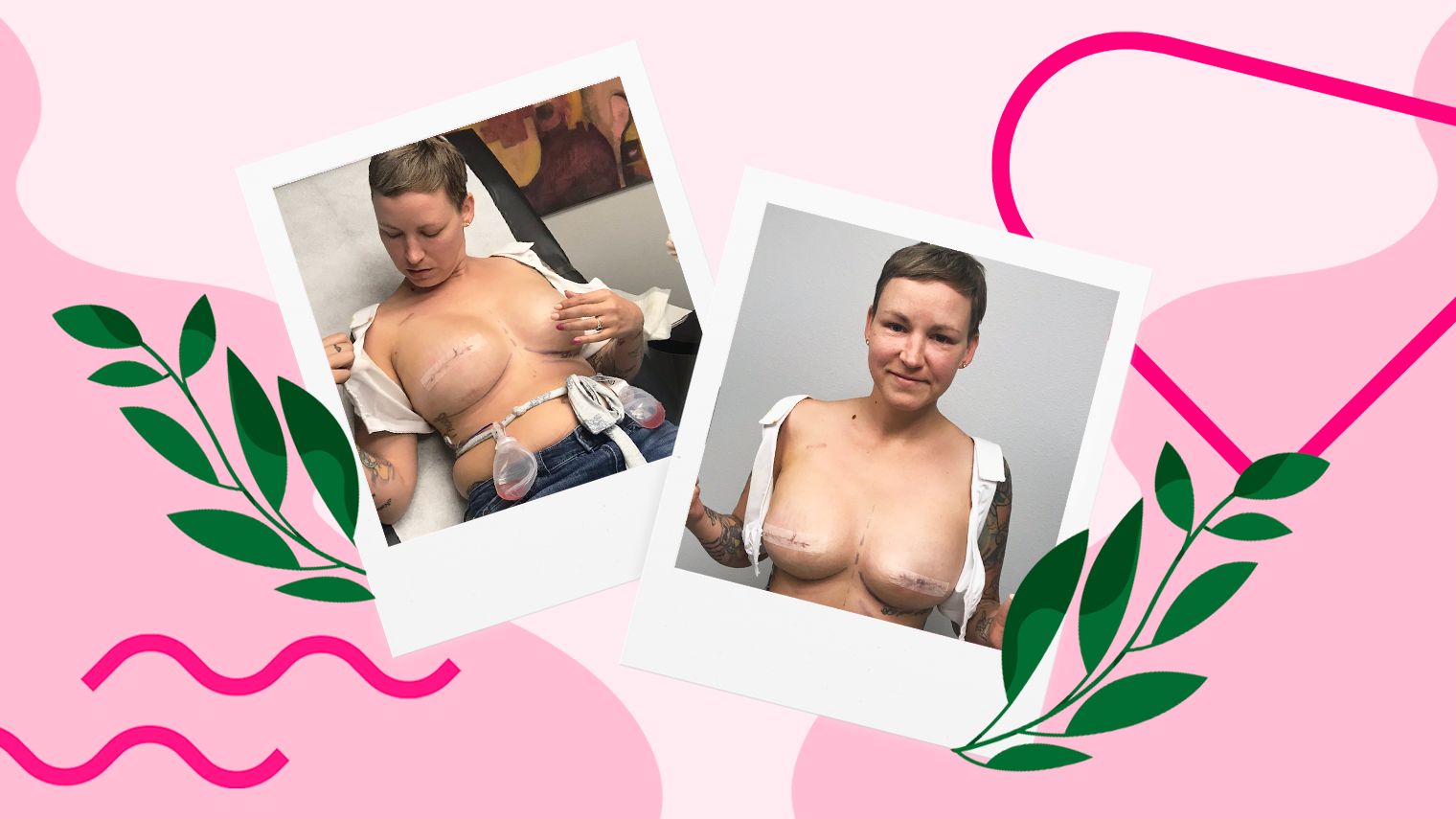Meeting My Mastectomy Scars and How I Cared for Them
August 03, 2023
Content created for the Bezzy community and sponsored by our partners. Learn More

Photos: Maggie Hundshamer-Moshier – Design: Alexis Lira
I thought I would hate my scars. But the aftercare process taught me to treat them with respect. When I finally saw them, it wasn’t what I expected.
As I shuffled into my reconstructive surgeon’s office one-week post-mastectomy, I knew one of the most emotional moments of my life was about to happen. I was about to see my mastectomy scars for the first time.
My emotions were all over the place. I was scared and excited, but most of all, I was resigned to the fact that no matter what I saw, those scars would be with me forever.
What I saw took me by surprise.


Getting ready for the viewing
Seven days earlier, I had left the hospital after a non-nipple-sparing bilateral mastectomy with tissue expanders in place to start my reconstructive process. I was exhausted — both physically and mentally — and couldn’t comprehend that my body was so different in just a matter of days.
I was given strict instructions to rest, to shower with help from others, and to make sure I did not scrub my surgical tape directly. My husband helped me in and out of the shower, gently helping me wash my hair and body as I closed my eyes as tight as I could.
I was terrified of what I would see and how I would react. I knew for my own mental well-being that I needed to be in a doctor’s office the first time I saw my new body.
When the moment arrived, the doctor removed all the bandaging, and as I looked down, I froze.
I had been so terrified of seeing these scars. I didn’t immediately love them, but they weren’t scary at all. I thought I was going to be repulsed or inconsolable, but I was just thankful. Thankful for what they meant. They meant I got more days with my children, more nights with my husband, and more years to live.
Taking care of my scars
Next came the process of filling my expanders and taking care of my scars so that they healed properly.
I was finally allowed to shower alone but had to make sure not to scrub my scars too hard to allow the tissue time to heal. I used a hydrocortisone cream to help soften the scars and had to remember not to pick at the tape until it was ready to come off naturally.
This cream made them heal so well that I began recommending it to everyone, and I still do.
I also began my exercises to help loosen the muscles in my chest and bring back my range of motion. This made a world of difference.
Six months later, my tissue expanders were replaced with more permanent implants, and scar repair started all over again.
One week after the reconstruction was complete, I was back at the doctor’s office. I had followed every instruction to the letter, and the anticipation was mounting to see my new body for the first time. I laid down on the exam table and was fortunate to have my husband in the exam room to photograph this moment.
4 years on, my scars are mine
Every cancer survivor’s journey and healing process is different. Some choose to have reconstruction and spare their nipples. Some choose non-nipple-sparing reconstruction. Some choose lumpectomy, and some choose no reconstruction at all.
No matter the choice, you must make this decision for yourself. I was quite young and had young children too. I wanted my life — with my clothes on — to be as seamless as possible for myself and my loved ones.
I am now almost 4 years post-mastectomy-and-reconstruction, and my scars remain much darker than other people’s. My tissue expanders and permanent reconstruction have stretched my skin as far as it can go, and my breasts always remain freezing. This leaves my scars with a deep purple appearance.
The surgical tape did exactly what it should and helped my scars heal straight and flat. When I wear clothing, you can barely tell I had surgery in the first place, and I am thankful for that. I take time daily to look at them in the mirror. No matter how many days postsurgery, I am still thankful to be alive. Looking at my scars reminds me of that.
I had an amazing local surgeon, and my scars turned out absolutely beautiful. The aftercare process was incredibly important to make sure they healed. This made me care for my scars. I was gentle and treated them with kindness. This made me have a more positive attitude toward them when I did finally see them. I’ve continued to respect them, and with time, I’ve learned to even love them.
Beyond what I can see
I was terrified of what I would see when I walked into my doctor’s office post-mastectomy. But when I left, I had a much larger understanding of what those scars truly meant. I was alive. In having to care for them, I was constantly reminded of this meaning. It took me a while to genuinely love them, and it is something I still work on.
If I could tell any cancer survivor one thing: Take care of your scars and embrace them. They help shape you and save you.
Medically reviewed on August 03, 2023


Like the story? React, bookmark, or share below:
Have thoughts or suggestions about this article? Email us at article-feedback@bezzy.com.
About the author